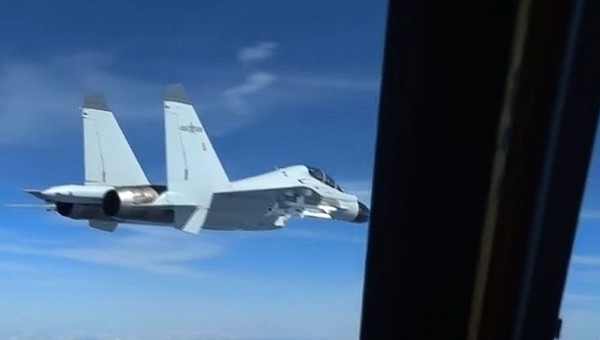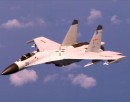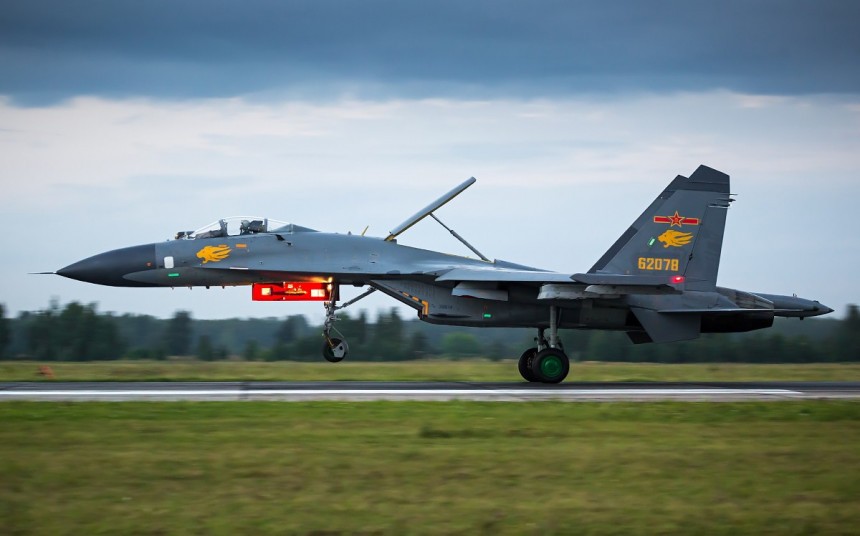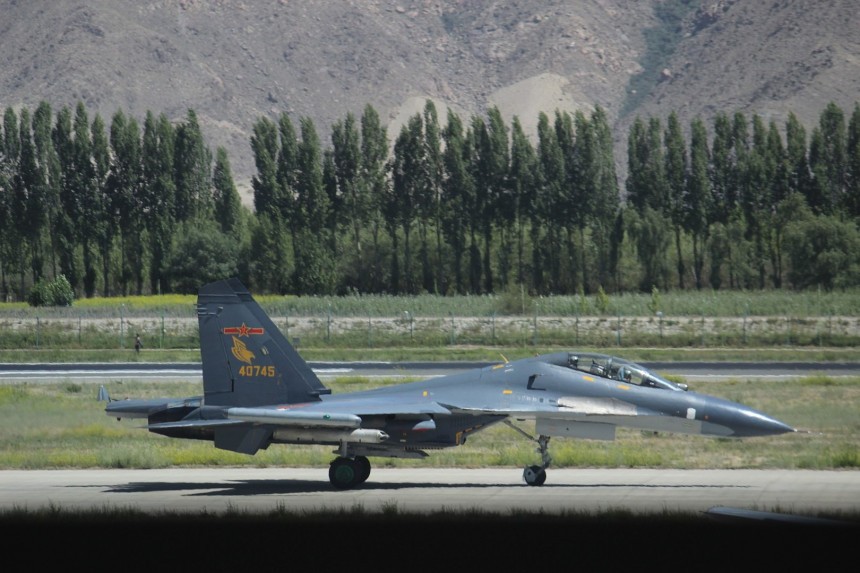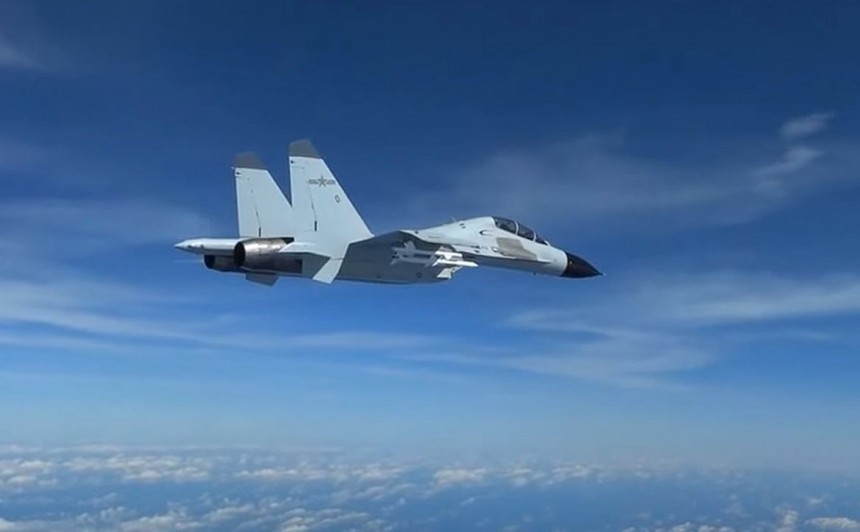Remarkable footage was making the rounds at the end of last month detailing an encounter between a NATO-aligned Boeing RC-135 reconnaissance aircraft and a Chinese twin-engine jet fighter. One that looks an awful lot like an old Soviet example.
Obviously, a Chinese fighter getting so close to an American jumbo jet that the Boeing's pilots can sniff the jet wash is a national security threat up the wazoo. One that undoubtedly angered NATO personnel at a time when their prime focus was not on the Chinese but instead on the Russians.
In truth, the Shenyang J-11 twin-engine Chinese air superiority fighter is a geopolitical marvel in itself. One steeped in a tradition of hot and cold relationships between two communist countries that an outsider with little knowledge of world history would assume were BFFs.
This may have been the case after the end of the Second World War when a breadth of Soviet aerospace technology was cordially shared with Chairman Mao Zedong's regime. This tech itself was recently ransacked from what remained of the defeated German military. Be it jet engines or the high-speed airframes that housed them, the Soviet and Chinese Air Forces went hand in hand in the days immediately following the bloodiest war in history.
Without getting into the nitty-gritty of Sino-Soviet relations that would bore most people to sleep, what it meant in the case of the Chinese Air Force was they'd at least have plenty of firepower to reverse engineer. The People's Liberation Army Air Force was founded in 1949 under the Communist Mao regime. Its first front-line fighter was, ironically enough, the not-Soviet-in-the-slightest P-51 Mustang.
A few British De Haviland Mosquitos were also purported to be in the early Chinese Air Force's ranks at that time. But with the coming dawn of the jet age already underway after the war, it makes sense that a good chunk of this newfound jet tech made its way to China by way of the USSR.
As far as western historians can tell, the Chinese jet age began with the Soviet Mikoyan-Gurevich MiG-15. In service with China, North Korea, and a handful of Soviet pilots on the sneak as the J-2, the anti-U.N. coalition came to love nimble, powerful Soviet design. The North Koreans still fly a handful of MiG-15s in 2022, much to the amusement of the rest of the world.
But what Mao wanted most was a domestic fighter. One which didn't rely on Soviet oversight to procure. Well, the lineage that the Shenyang J-11 hails from is made up almost entirely of reverse-engineered Soviet fighters like the MiGs 17, 19, and 21 and the Sukhoi Su-27. Even many Chinese domestic fighters, like the Shenyang J-8, bear striking resemblances to Soviet hardware. So much for wishful thinking.
Developed to support already flying fleets of Shenyang J-6s, essentially Chinese copies of the Soviet MiG-19, the J-11 is unmistakably built in the vein of the Su-27. China already operated a handful of Su-27s natively, being the first non-Soviet Communist nation to procure the fighters starting in 1991.
This deal, dubbed the 906 Project, marked the first time the PLAAF had access to jet fighter technology anywhere near the same level as NATO F-15 Eagles, F-14 Tomcats, Tornados, or Eurofighters. The delivery was completed on schedule. It was one of the very last major military deals between the Soviet Union and a foreign power's military before it all came crashing down in December of that year.
In 1996, the Shenyang Aircraft Corporation, a Chinese Communist Party-run facility, was selected to assemble pre-fabricated bits and pieces of Su-27 airframes partially assembled in Russia. The results of this first production run became the first of the Shenyang J-11s. The first J-11s were co-manufactured alongside Su-27s in Russia until at least 2004. From there, the Chinese took on the responsibility for the J-11s upkeep and maintenance more or less on their own.
Early J-11s, with their slightly outdated hardware, could not take advantage of more advanced Russian air-to-air missiles like the R-77. All because the early J-11s used Russian weapons and avionics. Because Soviet fire-control hardware had advanced by some degree by the late 90s, the J-11 made do with domestically made missiles like the PL-9 Infrared-homing AAM and the PL-8, based on the Israeli Python-3.
Early J-11s sported the same twin powerplants that made the Su-27 a force to be reckoned with in the dog days of the 20th century. Two all-mighty Saturn AL-31 afterburning turbofan engines cranking out 19,400 lbs (86.30 kN) of thrust each. Good for a top speed of 1,553 mph (2,500 kph, Mach 2).
This put the J-11s top speed on par with the F-15C Eagle or a Eurofighter Typhoon. The two NATO fighters most likely to have faced J-11s in combat during the late 90s and early 2000s had an alternate-history invasion of Taiwan that occurred roughly 20 years ago. Interesting alternate history theories aside, it's tough to ascertain how early J-11 would have fared in dogfights against Tomcats, Tornados, and Typhoons had they clashed.
But in regards to the upgraded J-11Bs, complete with all-Chinese Shenyang WS-10A engines, we suspect such a dogfight would be one heck of a display. That brings us to December 21st, 2022, when what appears to be a modern-spec J-11B decided to do some hot dogging around a U.S. Air Force RC-135 in what can only be described as a peacocking display at what looks like 30,000 feet or higher.
Hot dogging over international waters is nothing new in the 21st century. To a degree, it can even be called a routine occurrence. But each time one of these acts of aerial geopolitical tomfoolery in the sky takes place, it brings the world ever so much closer to a conflict no one truly desires.
It's entirely possible the J-11 could still be a formidable adversary in a hypothetical Sino-American war. But with fleets of F-22s and F-35S at NATO disposals alongside Eurofighters, Rafales F-15s, F-16s, and F/A-18s, expect the J-11 to take a back seat to the gen-v stealth fighters like the Chengdu J-20, or possibly even a production run of the prototype Shenyang FC-31 Gyrfalcon.
That said, the notion that China could attempt to take the Taiwanese island for themselves by force is not one to be taken lightly. If anything, these peacocking displays are only bound to increase as we approach ever closer to 2027 time from some experts peg as China's most opportune moment to strike. With Ukraine and Russia being in the picture, we're not so sure about that.
In any case, it would be bonkers to watch it all unfold. Let's hope for the sake of mankind that it doesn't.
In truth, the Shenyang J-11 twin-engine Chinese air superiority fighter is a geopolitical marvel in itself. One steeped in a tradition of hot and cold relationships between two communist countries that an outsider with little knowledge of world history would assume were BFFs.
This may have been the case after the end of the Second World War when a breadth of Soviet aerospace technology was cordially shared with Chairman Mao Zedong's regime. This tech itself was recently ransacked from what remained of the defeated German military. Be it jet engines or the high-speed airframes that housed them, the Soviet and Chinese Air Forces went hand in hand in the days immediately following the bloodiest war in history.
Without getting into the nitty-gritty of Sino-Soviet relations that would bore most people to sleep, what it meant in the case of the Chinese Air Force was they'd at least have plenty of firepower to reverse engineer. The People's Liberation Army Air Force was founded in 1949 under the Communist Mao regime. Its first front-line fighter was, ironically enough, the not-Soviet-in-the-slightest P-51 Mustang.
As far as western historians can tell, the Chinese jet age began with the Soviet Mikoyan-Gurevich MiG-15. In service with China, North Korea, and a handful of Soviet pilots on the sneak as the J-2, the anti-U.N. coalition came to love nimble, powerful Soviet design. The North Koreans still fly a handful of MiG-15s in 2022, much to the amusement of the rest of the world.
But what Mao wanted most was a domestic fighter. One which didn't rely on Soviet oversight to procure. Well, the lineage that the Shenyang J-11 hails from is made up almost entirely of reverse-engineered Soviet fighters like the MiGs 17, 19, and 21 and the Sukhoi Su-27. Even many Chinese domestic fighters, like the Shenyang J-8, bear striking resemblances to Soviet hardware. So much for wishful thinking.
Developed to support already flying fleets of Shenyang J-6s, essentially Chinese copies of the Soviet MiG-19, the J-11 is unmistakably built in the vein of the Su-27. China already operated a handful of Su-27s natively, being the first non-Soviet Communist nation to procure the fighters starting in 1991.
In 1996, the Shenyang Aircraft Corporation, a Chinese Communist Party-run facility, was selected to assemble pre-fabricated bits and pieces of Su-27 airframes partially assembled in Russia. The results of this first production run became the first of the Shenyang J-11s. The first J-11s were co-manufactured alongside Su-27s in Russia until at least 2004. From there, the Chinese took on the responsibility for the J-11s upkeep and maintenance more or less on their own.
Early J-11s, with their slightly outdated hardware, could not take advantage of more advanced Russian air-to-air missiles like the R-77. All because the early J-11s used Russian weapons and avionics. Because Soviet fire-control hardware had advanced by some degree by the late 90s, the J-11 made do with domestically made missiles like the PL-9 Infrared-homing AAM and the PL-8, based on the Israeli Python-3.
Early J-11s sported the same twin powerplants that made the Su-27 a force to be reckoned with in the dog days of the 20th century. Two all-mighty Saturn AL-31 afterburning turbofan engines cranking out 19,400 lbs (86.30 kN) of thrust each. Good for a top speed of 1,553 mph (2,500 kph, Mach 2).
But in regards to the upgraded J-11Bs, complete with all-Chinese Shenyang WS-10A engines, we suspect such a dogfight would be one heck of a display. That brings us to December 21st, 2022, when what appears to be a modern-spec J-11B decided to do some hot dogging around a U.S. Air Force RC-135 in what can only be described as a peacocking display at what looks like 30,000 feet or higher.
Hot dogging over international waters is nothing new in the 21st century. To a degree, it can even be called a routine occurrence. But each time one of these acts of aerial geopolitical tomfoolery in the sky takes place, it brings the world ever so much closer to a conflict no one truly desires.
It's entirely possible the J-11 could still be a formidable adversary in a hypothetical Sino-American war. But with fleets of F-22s and F-35S at NATO disposals alongside Eurofighters, Rafales F-15s, F-16s, and F/A-18s, expect the J-11 to take a back seat to the gen-v stealth fighters like the Chengdu J-20, or possibly even a production run of the prototype Shenyang FC-31 Gyrfalcon.
In any case, it would be bonkers to watch it all unfold. Let's hope for the sake of mankind that it doesn't.
